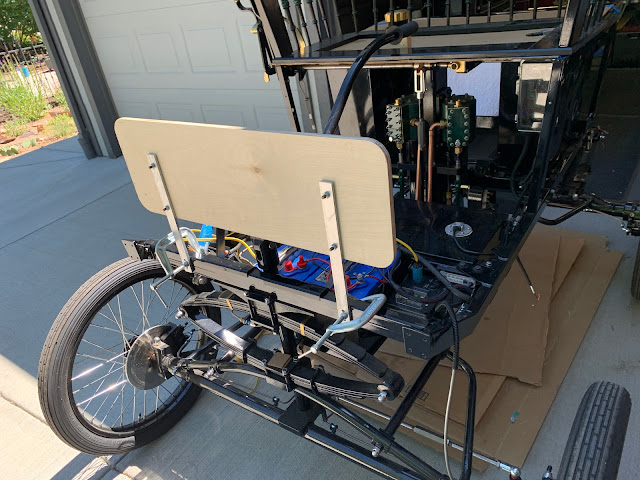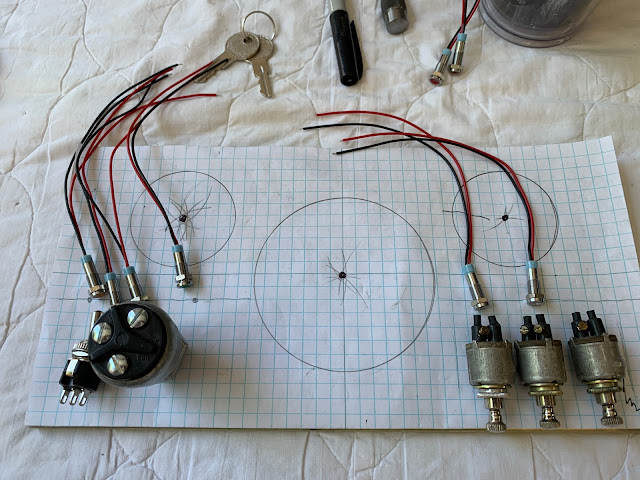The Stock Wire Loom (Harness) -
First - let's talk about the way the Lyka works from the perspective of "How does the burner work?" The heat source for the boiler is a Riello 40 Model G10 furnace burner. It has a rated output of 55-120 KW - which translates to 187000 BTU/hr up to 409000 BTU/hr. The burner runs on 220V (gotta love the UK and EU) this is sourced by an inverter that takes the dual 12V batteries and provides the 220. The inverter is turned on and off as heat is required, thus firing the burner in turn.
The fuel source is Diesel (Light Oil). The fuel "circuit" includes a tank, filter, and pump internal to the burner unit. There is no "pilot light". It is electronic start and burner status is sensed with some type of photocell. There is a squirrel cage fan built in to force the heat into the shield area under the boiler. It is deflected upwards, thru the multiple fire tubes, and out the "chimney" in the rear deck of the Lyka.
After I get the actual burner unit, I will do some open-air test firing to see how far the flame goes.
The stock electronic package is comprised of a small box with 4 fused circuits and two switches on the outside. Internally there are two relays. One relay is the Main circuit, the other is the ACC/Lamp circuit. The "main" switch turns on the Main Relay and enables the ACC Switch to turn on the ACC Relay.
The Main Relay controls voltage to the burner. The control circuit has two additional points of interruption, The water level system and the over-pressure switch. Either of these will interrupt the power to the relay and hence to the burner.
SO - if you have a cold boiler, with water in it, and you turn on the main switch, the burner will run until you run out of water (1/2 way) or reach max pressure.
If you turn on the main switch and then turn on the ACC switch - you get power to the Lights.
All in all a fairly automatic system. Just keep adding fuel and water.
Water Level Sensor (more details later)
My Modifications
My requirements for mods were defined in a previous post, but I will review them a little here.
1. Manual Cut-off of boiler.
2. Water and Fuel Level Display
3. Manual control of light circuits.
4. "Key Ignition" switch.
5. Speedo and Odometer.
6. LED Indicators of Burner Enable / Burner Active / Lamps
7. Brake Lights (Always available if Main is on).
Constraints:
1. System must minimally change the provided control box.
2. All "Loads" should run thru a relay.
3. Switches just control relays, relays control loads.
4. Tanks must be removable.
5. Wiring should be neat and labeled.
6. Grounds will be home-run as chassis is powder coated.
7. Additional circuits should be in weather-resistant boxes.
8. Dash system should be removable.
9. There should be "beak-points" for test access and system bypass.
The first step was to pre-wire the chassis. Identify the cable runs, deternine the access to the final locations, group the cables passing thru each major point, pull and protect, dress and terminate, and finally label.
I established a central access point for connection and test as well as bypass. I put a set of barrier strips on the inside of the chassis, on the opposite side from the pressure valve, sight glass connection and general future piping. At this location all loads and control circuits are accessible and can be bypassed if needed.
So I can completely remove my mods and the Lyka will still roll merrily along.
The connections to the Lyka lights, brakes, and power busses are on the right side. Connections to the control circuitry are on the left.
The stock control box now has a bit more cable traffic, but only two new connections inside,
one for the ACC power buss, and one for the burner override connection.
(The Yellow cable is the battery charger input point - A cigarette lighter socket)
The Remote Connection / Relay Box
Next I assembled the box I wanted for remote connections. I wanted a central location for the umbilical to the dashboard, and also individual relays for the Headlamp/Tail Lamp circuit and the Side Lamps. In my design I basically have what I call a Low-Amp and a Hi-Amp circuit. The Stock controller box has three circuits inside it. A Low-Amp, controlled by the Main Power switch - this enables the power to the burner relay, Hi-Amp to the burner and it also feeds the ACC Switch. The ACC switch controls a relay which provides Hi-Amp to the lights.
So Switches are Low-Amp to Relays, Relays control Hi-Amp to Loads/Burner.
In keeping with that concept, I wanted the dash system to run Low-Amp to Relays in the Remote Box and the relays to enable the ACC Main Hi-Amp power to go to the various lamps. This is because all of my lamps are converted to electric, but might use a variety of bulbs. Since I wanted to use some "vintage" switches for lamps on the dash, I wanted only Low-Amp circuits to go thru them.
First the box -
Then a circuit for each load with relays, LEDs and connection points.
Then fitting it in the box along with a junction strip. The junction strip contains the color-coded multi-conductor cable that is the umbilical to the dash system.
I was working upside down because the other end of the cables were already attached to the car.
I decided to mount the box to a plate that was suspended from the main cross bar of the chassis/body. This will keep the box safer in the future when things get crowded in there. I mounted it as far away from the engine cylinders as possible.
The Dashboard
Design criteria -
1. Needed to be smaller than the front panel of the Lyka.
2. Needed to be able to be removed and replaced easily.
3. 1 connector umbilical.
4. Fit into the general color scheme of Black and Brass.
5. Contain the controls previously determined.
6. Build from available pieces and parts.
7. Be angled for viewing - like the Clock.
8. Look cool.
So - Starting with the board itself - needed to determine an optimal size. I also needed to source a piece f quality plywood. I chose a good clear Birch Veneer plywood as I liked that it had tight glue layers as seen from the side and two clear sides, no knots or patches.
Then I found two pieces of 1"x 1/4"aluminum bar to cut the brackets from.
I decided to round the corners so the brass banding I am locating will be easier to install after the finish is done.
In keeping with my new wood finishing process, I coated the dash with the ESP-155 Epoxy.(see Seat Log)
After giving it a few days to cure, I sanded it down and used Rustoleum Gloss Black Automotive Paint.
(I think I need to perfect my sanding technique - but it looks pretty good.)
Control System
The control box will be mounted on the dash. I made it from some available scraps of brass. I used JB-Weld in stead of actually soldering as I thought that having to solder multiple seams and keeping things from warping/melting might be a PIA.
I decided on a layout - the Mickey Ears one. I am putting the ignition and cutoff switch on one side and the lighting switches on the other. I had to play for awhile to get the viewing angle to match the clock I had, and then came up with a way to secure the shell to the base, and still be removable. I attached some "L"Brackets made from brass angle to the base and then drilled and tapped holes for socket screws.
Unfortunately, the piece I have for the front panel is in the roughest shape. Some previous holes that were soldered closed and scratches. It did have the nicest corners and allowed for the box assembly to go quite smoothly.
The end result:
And in place:
Well,
That's about it until I get another shipment. I may have to go back to playing with boats and miniature steam in order to keep my fingers from itching.
One last picture - The brass banding came in, I added counter-sunk holes for brass wood screws. Here it is in place:
Thanks for reading,
Poppapope
Denver, CO
USA












































